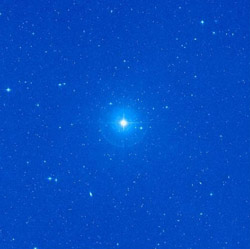 Astronomers announced today the discovery of at least four – and as many as six – planets orbiting two nearby stars. These planets are relatively low mass, ranging from 5 to 25 times the mass of the Earth. For comparison, Jupiter is over 300 times more massive than the Earth, and Uranus 15 times our mass.
Astronomers announced today the discovery of at least four – and as many as six – planets orbiting two nearby stars. These planets are relatively low mass, ranging from 5 to 25 times the mass of the Earth. For comparison, Jupiter is over 300 times more massive than the Earth, and Uranus 15 times our mass.
Three of these extrasolar planets orbit the nearby star 61 Virginis, which is only about 28 light years away (that’s a stone’s throw in galactic terms). 61 Vir has been a target for planet hunters for some time because it’s very much like our Sun: while it has slightly less mass and is a tad less bright, its temperature is almost the exactly the same as the Sun’s. It’s about 6 billion years old, 1.5 billion years older than the Sun. It’s bright (easily visible to the unaided eye from a dark site), making it easy to study. It also has a very similar chemical composition as the Sun, which may be important in the planet-making business. And now we know it has planets! Little ones, too.
Here is a schematic of the system:
Inner planets in our solar system are shown with dotted lines, and the three 61 Vir planets as solid lines. As you can see, they all orbit closer than Earth does to the Sun, and the third one out has a fairly elliptical orbit. In order from their star, the planets have masses of approximately, 5, 18, and 24 times the Earth’s mass (they may be somewhat more depending on our viewing geometry, which is difficult to determine). They orbit 61 Vir in 4, 38, and 124 days respectively. While all of these are far more massive than the Earth, they represent big steps forward in finding more Earthlike planets, since they are in fact low mass compared to other planets found, and the outer one takes longer to orbit than usual as well.
Interestingly, recent Spitzer Space Telescope observations indicate a fairly hefty ring of dust around 61 Vir as well, at a distance of about twice the distance of Neptune from the Sun. This probably comes from collisions of comets and asteroids, meaning that this system 300 trillion kilometers away really does look a lot like our own solar system.
On top of that, another sunlike star, HD 1461, was found to have at least one planet orbiting it. The planet has about 7.5 times the Earth’s mass, and orbits close in, taking six days to circle the star once. There may be two other planets orbiting this star as well, but the signals from them are just a bit too weak to be sure.
All of these planets were found by analyzing the stars’ light and looking for a periodic Doppler shift. As a planet orbits its star, it in turn pulls the star around very slightly, and that can be seen as a teeny shift in the wavelength of the starlight. And by teeny, I mean really teeny; it’s only been the past 15 or so years that this method has been refined enough to yield results.
So this is very cool, and brings us another step closer to what we all really want to find: a terrestrial planet orbiting a star in an Earthlike orbit. That doesn’t guarantee life – heck, it doesn’t even guarantee the planet will look anything like Earth at all (just take a peek at Venus and Mars to confirm that), but this new discovery does mean that lower-mass planets are abundant in the galaxy. And that’s very cool news indeed.
Orbital schematic credit: Chris Tinney